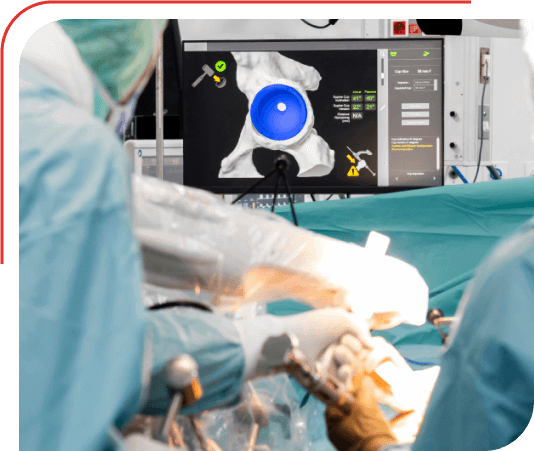Home » Speciality » Robotic Knee & Hip Replacement Surgery
ROBOTIC KNEE REPLACEMENT AND HIP REPLACEMENT SURGERY

Why choose Wockhardt Hospitals for Knee and Hip Replacement Surgery With Mako SmartRobotics™ System?
Wockhardt Hospitals in Mumbai stands out as the premier choice for Mako SmartRobotics™ System Assisted Hip and Knee Replacement surgeries. We are equipped with technologically advanced facilities and robotic equipments. We also offer the latest and top-notch quality Knee and Hip implants that can be specifically designed to meet the individual requirements of patients. The team of extensively experienced orthopaedic surgeons and consultants provides supreme surgical expertise to deliver outstanding Knee/Hip Replacement results with a high rate of success.
Renowned Gastroenterology
at Wockhardt Hospitals
- Mumbai Central
- Mira Road
- Nagpur
- Rajkot
Mako SmartRobotics™ System Assisted
Knee Replacement and Hip Replacement Surgery
The introduction of Mako SmartRobotics has wholly changed how orthopaedic surgeries are performed in terms of surgical accuracy and innovation. Mako, a revolutionary device in the medical profession, combines robots with surgical knowledge to improve the precision and efficacy of surgery, notably in orthopaedics. With its potential to benefit patients and surgeons, it presents a revolutionary change in orthopaedic practice and, eventually, patient care.
What is Mako SmartRobotics™ System?
Mako SmartRobotics™ System is a surgical system designed to aid orthopaedic surgeons in performing procedures with unparalleled precision. Developed by Stryker Corporation, this cutting-edge technology integrates 3D imaging, pre-surgical planning, and robotic assistance to enhance surgical outcomes, particularly in joint replacement surgeries.
The Mako SmartRobotics™ System incorporates three critical components: 3D CT-based planning, AccuStop haptic technology, and smart data analytics, into a single platform that has demonstrated improved results for total hip, complete knee, and partial knee patients. The doctor uses three-dimensional computed tomography imaging to create a comprehensive picture of the joint before treatment. This imaging helps the surgical team pinpoint the replacement joint by providing them with an accurate view of the patient’s unique anatomy.
Additionally, the Mako robot uses this image to virtually reconstruct the joint and assist the surgeon in making only the necessary cuts using preprogrammed stop points. Mako aids surgeons in adhering to the specified rules of individualised treatment, allowing for more precise alignment and installation of the replacement joint by directing Mako SmartRobotics™ System inside the predetermined area created using the CT scan.
Features of Mako SmartRobotics™ System
- 3D Modeling and Planning: Mako utilises high-resolution imaging to generate a 3D model of the patient’s anatomy. Surgeons can then plan and simulate the procedure with remarkable detail and accuracy even before entering the operating room.
- Robotic Arm Assistance: This arm aids in executing the pre-planned surgical actions with a level of precision that is difficult to achieve through traditional methods.
- Real-Time Guidance: Mako provides real-time data and feedback to the surgeon throughout the surgery, allowing for adjustments and ensuring the planned procedure aligns with the actual condition.
- Minimally Invasive: Mako facilitates minimally invasive surgery, resulting in smaller incisions, reduced scarring, and quicker recovery times for patients.
What is Mako Smart Robotic Hip Replacement Surgery?
For individuals with inflammatory or non-inflammatory degenerative joint degeneration of the hip, Mako technology can be utilised in Hip Replacement treatment. To help you prepare ahead for your hip replacement, Mako technology offers 3-D models that are customised for each patient. This procedure is also minimally invasive as it is performed with the assistance of Mako SmartRobotics™ System controlled by surgeons. This allows them to make smaller and more precise incisions to access and remove the necessary parts of the damaged hip.
Hip replacement surgery requires utmost precision, but the distinct anatomical structure of the hip can be very subtle. Making an incision a fraction of an inch away from the intended site can cause damage to healthy tissue, which may lead to pain, instability, and even immobility. With the Mako SmartRobotics™ System and precisely controlled movements, surgeons can perform specifically tailored surgeries suited to the unique needs of a patient’s anatomical hip structure. This can lead to optimal recovery with minimal intervention and damage, allowing patients to get back on their feet in no time.
What is Mako Smart Robotic Knee Replacement Surgery?
Mako creates a customised surgical plan for you based on your particular anatomy. With the use of Mako technology, your surgeon may pre-plan your total knee replacement by using a patient-specific 3-D model. They use your patient-specific strategy to direct the Mako SmartRobotics™ System throughout the surgery. This innovative surgical technique allows surgeons to make smaller incisions with greater precision and reduce the overall surgery time. Utilising a minimally invasive surgical approach also promotes faster postoperative recovery and reduces the risk of complications, resulting in better outcomes.
Who is a Good Candidate for Mako Smart Robotic Knee and Hip Replacement Surgery?
Mako knee replacement procedure is a good option for patients who:
- Have severe pain in the knees due to conditions such as arthritis.
- Have been suggested to undergo this treatment.
Mako hip replacement procedure may be recommended for patients who:
- Experience hip pain that interferes with their daily activities.
- Have not achieved the expected results from non-surgical methods of hip pain treatment.
Mako is not recommended for use in patients with specific infections, mental or neuromuscular disorders that would unacceptably increase the risk of prosthesis instability, problems with prosthesis fixation, compromised bone stock, skeletal immaturity, severe joint instability, or excessive weight.
Benefits of Mako SmartRobotics™ System:
- Enhanced Precision and Accuracy: Mako’s advanced imaging and robotic assistance empower surgeons to perform procedures with an unprecedented level of accuracy, resulting in improved patient outcomes and a reduced risk of complications.
- Customised Planning: The 3D modelling capability allows for personalised surgical plans tailored to each patient’s unique anatomy. This customisation ensures a more precise fit and alignment of implants, optimising functionality and longevity.
- Minimal Impact on Adjacent Tissues: The Mako SmartRobotics™ System enables surgeons to make more accurate and smaller incisions, resulting in less blood loss and reduced harm to surrounding blood vessels, nerves, and tissues. Patients benefit from fewer side effects and a decreased chance of post-surgery problems.
- Reduced Pain and Faster Recovery: Patients undergoing Mako-assisted surgeries often experience less post-operative pain and achieve quicker rehabilitation, enabling a faster return to their daily activities.
- Long-Term Implant Durability: The precision achieved with Mako technology leads to better implant positioning, potentially increasing the lifespan of joint replacements and reducing the need for revision surgeries.
Why Choose Mako SmartRobotics™ System Assisted Surgery over Traditional Open Surgery?
The advantages offered by Mako SmartRobotics™ System Assisted Surgery over traditional open surgery are considerable:
- Mako SmartRobotics™ System allows for unparalleled precision, reducing the risk of human error that may occur in traditional open surgery.
- Mako enables minimally invasive procedures, resulting in smaller incisions, reduced blood loss, and faster recovery times compared to open surgery.
- Mako's ability to create a personalised surgical plan based on each patient's anatomy ensures a tailored approach, improving outcomes.
- The precision and real-time feedback provided by Mako help minimise the risk of complications during and after surgery, improving overall safety.
- Patients undergoing Mako-assisted surgery often experience shorter hospital stays and faster recovery periods compared to those undergoing open surgery.
- The precision and accuracy of Mako surgeries may lead to better long-term outcomes, potentially reducing the need for additional surgeries in the future.
How to Prepare For Mako SmartRobotics™ System Assisted
Knee & Hip Replacement Surgery?
Mako Knee Replacement Surgery Preparation
Before undergoing a Mako Robotic knee replacement procedure, doctors and/or surgeons may recommend that the patients undergo certain tests, such as blood tests and imaging tests, to assess the severity of the joint condition and inflammation. These tests may include the following:
- Complete blood count (CBC) test
- Coagulation test
- X-ray
- CT scan
- MRI scan
For advanced geriatric patients with certain health conditions, doctors may perform a pre-anesthesia check-up to assess the suitability of the patient for the operation. Patients may be advised not to consume food for at least 6-8 hours before the surgery.
Mako Hip Replacement Surgery Preparation
Before scheduling Mako hip replacement surgery, doctors may require patients to undergo certain tests to assess the overall health condition of the patient and identify if any specific precautions need to be taken. These tests may include:
- Blood tests
- Computed Tomography (CT) scan
Doctors may recommend making certain changes for better recovery after Mako Robotic hip replacement surgery. These suggestions may include:
- Avoiding blood thinner medications approximately 1-2 weeks before the surgery.
- Completing any dental procedures at least 6 weeks before surgery to avoid the risk of infections.
- Stopping smoking and losing weight, if required.
What Happens During Mako
Robotic Knee Replacement Surgery?
The robotic Knee Replacement Surgery in Mumbai is usually performed under general anaesthesia to ensure that the patient does not feel any pain during the surgery. Your surgeon will create a three-dimensional virtual model of your knee using Mako. With the assistance of Mako SmartRobotics™ System, surgeons may make small incisions at the intended site of surgery and remove the damaged tissue/joint, which is then replaced by an artificial joint implant. After the installation of the implant and if it is in the right location, surgery may be performed to carry out this plan. The surgical tool will be held by the Mako SmartRobotics™ System and the doctor while you are under general anaesthesia. Your surgeon will have complete control over the tools during the procedure, and he or she will be able to view the pre-surgical plan superimposed over the live operation as a reference.
The tracking eyes on the robotic device allow it to detect and adapt to even the smallest knee motions. Removing only the damaged portion, it meticulously prepares the bone in accordance with visible borders that safeguard the knee’s core structure. The joint is correctly adjusted, the implant is inserted, and your surgeon can make any required changes.
What Happens During Mako
Robotic Hip Replacement Surgery?
A Mako robotic-assisted Hip Replacement Surgery in Mumbai is almost similar to a standard hip replacement procedure, except for a few differences. The robotic hip replacement procedure may be performed under spinal anaesthesia with sedation or general anaesthesia, as needed. Before the surgery, the patient undergoes imaging scans, typically CT scans, to create a 3D model of the hip joint. The Mako system loads this virtual model, which is then utilised to generate a personalised pre-operative plan. During surgery, the Mako system utilises this personalised plan to assist the surgeon in executing the operation. Once the patient is under anaesthesia, the surgeon makes an incision to access the hip joint. Mako SmartRobotics™ System is then employed, providing real-time data to guide the surgeon’s movements and ensure precise bone preparation.
The Mako system allows for dynamic adjustments during surgery. The surgeon can verify the alignment and make any necessary modifications based on the patient’s unique anatomy, enhancing the overall precision of the procedure. Furthermore, Mako SmartRobotics™ System haptic guidance offers resistance feedback, preventing the surgeon from deviating from the predetermined plan, ensuring that the intended surgical boundaries are respected.
Follow-up & Recovery after Mako
Robotic Hip & Knee Replacement Surgery
After undergoing Mako robotic hip and/or knee replacement surgery, the surgical and care team usually monitors the progress of recovery post-surgery. They may help relieve any pain or discomfort caused after the anaesthesia wears off. Regular check-ups and assessments are necessary for monitoring the progress of recovery. Although recovery may depend on the age, overall physical health, and physical activity of the patient, it typically happens faster and with fewer complications compared to traditional surgery.
To manage any symptoms of pain or possible infections, appropriate medications may be recommended by the treating orthopaedic doctor to ensure optimal recovery and outcomes. Additionally, patients may undergo physiotherapy sessions with occupational and physical therapy experts to accelerate joint recovery and improve joint movement.
Risks and Complications of Robotic Knee & Hip Replacement Surgery
Although the Mako robotic knee and hip replacement procedures are minimally invasive surgeries that involve minimal incision and intervention, there can be certain complications.
Robotic Knee Replacement Surgery Complications
The risks associated with the robotic knee replacement procedure include:
- Infection at the site of surgery.
- Formation of blood clots, pulmonary embolism, deep vein thrombosis, etc.
- Swelling and blood loss following damage to any surrounding tissue or blood vessels.
Robotic Hip Replacement Surgery Complications
The potential risks associated with the robotic hip replacement procedure include:
- Nerve damage
- Infection
- Blood loss
- Blood clot formation
- Bone formation in soft tissues
Although the movements are performed in a highly controlled environment, these risks may still occur.
Summary
Mako SmartRobotics™ System Assisted Surgery represents a significant advancement in surgical procedures. Its combination of precise instruments, enhanced imaging, and robots provides numerous advantages that significantly elevate the standard of patient care. As technology advances, Mako exemplifies the potential of robots to enhance healthcare results and improve patients’ quality of life.


























